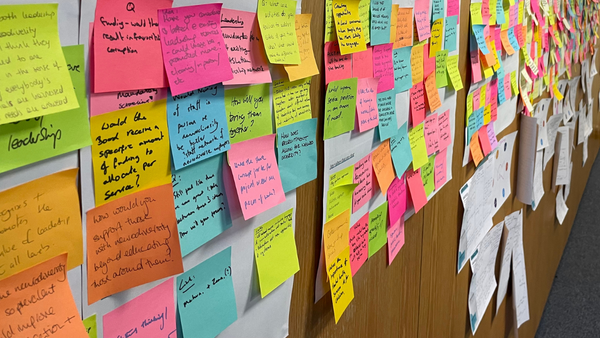If we want to survive austerity, let alone improve places and lives, we must attend to the human dimensions of public service leadership.
During 2014 I have attended, chaired, or spoken at, countless meetings on public service reform strategy. Yet two of the most powerful examples of the possibilities of reform were spontaneous and personal.
The first was in a working group on reducing unemployment in an inner London borough. As facilitator of the group, I had insisted at an earlier meeting that the local providers of the Work Programme be invited to join our deliberations. This was rather against the instinct of the local authority whose members had a tendency to see the providers as untrustworthy and unhelpful private sector profiteers.
With the meeting trundling on and the various agencies staying within their comfort zones, out of sheer frustration I tried something new. I invited everyone in the room to speak directly to another person: ‘Tell them’, I suggested, ‘something they could do differently which would help you do your job of tackling unemployment’. After an uncomfortable silence it was one of the Work Programme providers who piped up. She described how several of her customers had received advice from the council’s welfare rights team and, as a consequence, had been able to secure a bit more money or to avoid having to join the Programme. ‘It’s not that I don’t want them to exercise their rights or get their entitlements’, she said ‘it’s just there doesn’t seem to be any message about the value of trying to get a job’.
All eyes turned to the rather fierce senior council officer. Her reply was powerful, something along the lines of ‘You are absolutely right. I am really glad you’ve raised it. I am going to go back and look at how we can change the remit of the team and the job descriptions of staff to put a much stronger emphasis on promoting routes to work’. This brief interaction released the whole room to start being a lot more open about their frustrations and aspirations. At last we started to move beyond the lazy, generic bleating about things ‘not joining up’ or ‘everyone working in silos’ into concrete issues, requests and commitments.
Then earlier this week I was invited to speak to and facilitate a meeting of the Essex Partnership Board (made up of public and voluntary sector agencies from across the county), chaired by the very direct and thoughtful council leader David Finch. In the first part of the meeting I spoke about collective impact methodologies; identifying a shared mission, agreeing key metrics, sharing out clearly differentiated roles and responsibilities, committing to high levels of communication and having a backbone organisation to hold the process together and maintain momentum. Everyone seemed keen, although perhaps more in principle than practice.
Then something startling happened. A leading officer of a local NHS Clinical Commissioning Group premised his/her comments (I have to be careful here as telling the truth about the growing winter crisis can be a career-ending move in the NHS) by describing the week he/she is having. In essence with norovirus on the move and flu figures starting to rise, the NHS is already at breaking point with long and growing waits for ambulances and in A and E, and a chronic shortage of staff and beds. One consequence is frail people being discharged to return to empty homes at midnight.
The officer was about to move on to the presentation when I merely expressed the palpable mood in the room: ‘how can we talk about the ambitious, collaborative principles of collective impact and then not apply them in the face of a challenge like this?’
Within a few minutes the CCG manager was surrounded by a gaggle of fellow leaders discussing what they could all do to help. One promised to co-ordinate a communication to all their staff about getting the flu jab and looking after the health of family and neighbours, while someone from the voluntary sector committed to directing more volunteers to A and E departments to accompany people home when they are discharged at night. The room was full of energy as the managers were powerfully reminded of the very reason they joined the public and voluntary sector in the first place.
Public service reform can often seem like a very dry and technocratic process. Of course, it is important to be systematic, to prioritise, to apply the best evidence of what works etc but, as I argued in a recent post, if our aim really is transformation (anything less will mean a declining public sphere) we will also need a different quality of leadership: seeing the whole system, creating genuine conversation and moving from reaction to co-creation.
Even beyond that there is, it seems, a vital emotional dimension. We live in a world of competition, public relations and 24 hour media; a world where expressing fear or vulnerability as a leader can feel very dangerous. In this world the most powerful way to turn a group of people guarding their organisations into a team passionately committed to shared action isn’t offering help, but asking for it.
Related articles
-
Our social insecurity system
Hannah Webster
How can we regenerate our social security system to remove insecurity and ensure everyone is receiving the support they need to survive?
-
The importance of public entrepreneurship
Ian Burbidge
Our healthcare system needs transformational change that creates the space for a new paradigm to emerge. Read about how our public entrepreneurship project can support this.
-
How can we cultivate healthier and happier communities?
Ella Firebrace Riley Thorold
How might we look to our futures and shape what it means to lead healthier and happier lives?




Join the discussion
Comments
Please login to post a comment or reply
Don't have an account? Click here to register.
There is great power in collective approaches that involve a broad range of stakeholders. The power lies partly in the power of open dialogue - on which much has been written, though not as often practiced, for it takes skilled leadership and facilitation to enable authentic, open and vulnerable communication. It also lies in leadership - the type of collective leadership that creates a space for cross boundary collaboration, creativity and support.
The work of Nesta and the Rapid Results Institute with a few of the NHS teams in Essex is a great example of this.
🌴It's LEADERSHIP! @irnva twitter also
arob99 facebook charted my own way.
A whole systems approach is good - but it needs to be involving users, staff and stakeholders. The 'great and the good' type of workshop may not lead to real improvement - especially when the 'great and the good' have returned to their own organisations and tried/failed to sell their idea to their own people and maybe realised they didn't know as much as they thought or other blocks were in place that they knew little about or their performance measures won't allow flexibility ..... I like what John Seddon says in his book - 'The Whitehall Effect' - a systems approach, listening to users when designing services and acknowledging that 'quality services' are not too costly. Poor quality services are very expensive and the public sector is full of them ...